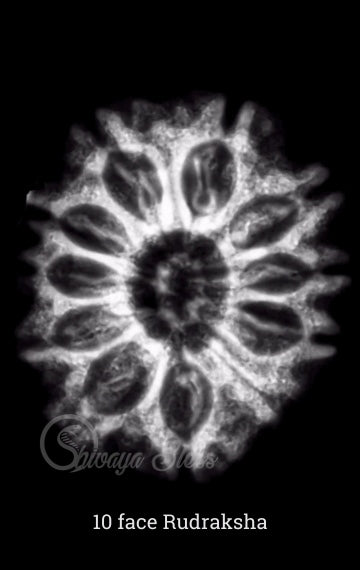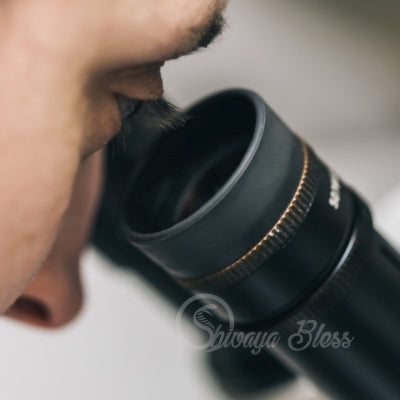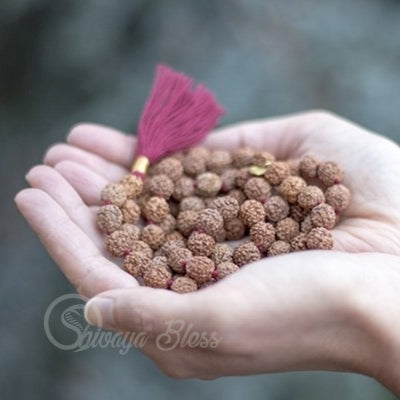

Most likely, the first question that comes to your mind before acquiring a Rudraksha is, “How do I know if this bead is authentic?” With climate change affecting the supply, and rising demand caused by increased awareness, the Rudraksha market has become flooded with counterfeit beads and fake certifications, making it challenging to locate genuine beads. In fact, for every real bead, approximately 3 to 4 fakes exist.
Why do fakes exist?
Around 70% of Rudraksha tend to be the 5 face (Panchmukhi). As we diverge from the 5 face, either to higher or lower faces, the rarity and price grow exponentially. Thus, many sellers manufacture imitations, especially of the rare varieties, at very low costs and try to sell these using below market pricing. While experienced buyers know that beads that cheap are usually fake, many unsuspecting newcomers fall victim to this scam.
Why is authenticity important?
Authenticity is crucial for Rudraksha, as their efficacy is directly linked to their genuineness. Real Rudraksha have countless benefits (E.g.: They emanate positive vibrations and possess healing properties that can benefit the wearer both spiritually and physically). On the other hand, imitation beads not only lack these divine qualities but may also contain inferior materials that may harm the wearer.
In this comprehensive guide, we will learn about fake Rudraksha beads and foolproof ways to authenticate Rudraksha, ensuring that you do not fall prey to counterfeit products.
How are fake Rudraksha made?
Using a mold
-

Imitation 5 face mala
Since mass production minimises costs, even 5 face beads, the most common face, are sometimes fakes.
-
This method allows for mass production, and is used to produce beads at a fraction of the actual cost. In fact, there are designated factories in India and China solely producing these imitation products. Usually, materials like plastic, wood or clay are used.
Rudraksha are natural seeds with imperfections, and will never be 100% uniform. However, these imitation beads will look exactly uniform and perfect, with a very smooth surface.
-

Plastic 1 face bead
This bead has been cut horizontally to reveal the shiny plastic material.
Gluing beads together
-

Fake 21 face Rudraksha with certification
Usually, beads that are glued together will come with x-ray certification, to make it seem more trustworthy.
-
This high-level technique allows sellers to create either beads with high faces, or unique beads like the Gauri Shankar and Trijuti. Even an x-ray will be unable to distinguish these beads, as the imaging and seed count will tally.
When viewing the Rudraksha very closely, you will be able to identify any artificial joints. This is especially if an inexperienced craftsman has glued the beads together, as the joint area will look different.
-

3 beads glued together to form a Trijuti
One of the rarest and most expensive Rudraksha, most Trijutis tend to be fakes, like the one pictured.
Carving artificial lines
-

Fake 21 face Rudraksha
This bead involves both gluing and carving artificial lines.
-
Sellers may hand-carve lines to increase the number of faces on their beads, thus causing their value to rise. Usually, only a few lines will be artificially carved, while the rest will be natural lines; this makes it less obvious and harder to spot. Carving just 1 line on a bead can cause the value to more than double.
Regardless of the artisan’s skill level, a hand-carved line will never look the same as a natural line - it tends to look sharper and unnatural. However, differentiation might be challenging.
-

Fake 21 face Rudraksha
Many fakes come with a capping, which prevents proper scrutinisation.
Hiding lines
-

5 face mala transformed into a 1 face mala
Each bead in the mala has been artificially altered into a 1 face bead, using a sandpaper to erase the lines.
-
This method is usually used to create a round Nepal 1 face bead. Small Rudraksha pieces are used to cover the lines on a bead, or sandpaper is used to erase the lines (E.g.: A 5 face bead can be converted into a fake 1 face bead by concealing 4 faces).
Round Nepal 1 face beads do not exist. This is one of the most common scams in the Rudraksha market. 1 face beads only come from India (Big, half-moon shape) and Indonesia (Small, oval shape). When viewing the Rudraksha very closely, you will be able to identify any covered lines.
-

5 face bead transformed into a 1 face
4 of the faces have been filled with Rudraksha sediments, such that there is only 1 complete line.
Carving holy symbols
-

Fake 1 face bead with many carvings
This is claimed to be a 1 face bead, with a line on the bottom. Actually, it is made of a clay-like substance.
-
Some sellers carve symbols (E.g.: Om, trishul, lingam, and serpent) onto Rudraksha or similar-looking stones and claim that these symbols appeared naturally to sell the beads at exorbitant amounts.
Very rarely, Rudraksha may showcase these symbols naturally, but it will never be clear or sharp. Avoid Rudraksha with unnaturally sharp and distinct markings, as they have been altered and are not natural.
-

Beads with various carvings
These are carved out of a random scaly fruit. However, they are being sold as Rudraksha.
Selling similar-looking seeds
-

Fake 21 face Rudraksha
Not only is this bead's appearance different, but it also has an unnaturally large central hole.
-
Many other trees that do not belong to the Elaeocarpus ganitrus (Rudraksha) family bear fruits that look very similar to the Rudraksha. These may be passed off as Rudraksha, with hand-carved lines, and an untrained eye might not realize the difference immediately. Most commonly, betel nuts are used.
These fakes, when compared side-by-side with actual Rudraksha, have a different appearance, texture, etc.
-

Fake 21 face Rudraksha
This bead's sharp, perfect lines are a giveaway that it is handmade and not natural.
How can you check if a Rudraksha is real?

The X-ray Test
In a real Rudraksha, each face or mukhi represents 1 internal seed compartment containing a seed. There should also be a central hole. An X-ray can be used to analyse these components, and is one of the most accurate methods of verification.
However,
- X-ray services are not easily accessible. Additionally, the seeds might be very small, or the compartments very close together. In that case, a CT scan is required, which can be even more expensive.
- Beads that have been glued together will pass the x-ray test, as the number of internal seeds and compartments will tally. Since many blindly trust x-ray certifications, manipulative sellers often glue beads together to form rare, expensive beads like the 21 face or Trijuti, and offer certification to gain trust.

The Microscopic Observation Test
Regardless of how well a fake Rudraksha is designed, this test can be used to distinguish any irregularities, such as a different material, artificial lines, artificial joints, etc.
However, an inexperienced person may not be able to immediately distinguish irregularities with confidence, especially when each origin has a slightly different appearance.

The Energy Test
A sensitive person can feel the energy or vibrations of a Rudraksha when holding it and focusing.
However, this test only works for people sensitive to the energies surrounding them, and is especially challenging for the less energetic lower faces that contain less seeds. Those who meditate or chant regularly might find this method suitable.

The Cut Test
Each face represents 1 internal seed compartment containing a seed. Horizontally cutting through a Rudraksha bead to reveal the cross-section will allow viewing of these components.
However, although it is the most accurate method, your precious Rudraksha will be destroyed and it is thus not advised.
Are there any fake tests?
The following tests are illegitimate and inaccurate, and are commonly used to trick unknowing buyers. Moreover, they only test whether the bead is indeed a Rudraksha. None of them consider the possibility that the bead may be a Rudraksha, but the faces might be artificial.
Collapsible content
The Water Test
Supposedly, Rudraksha beads are denser than water and will sink.
However, fake Rudraksha can be injected with lead or other dense compounds to increase the bead’s overall density, for them to sink in water. Moreover, real beads may float or sink, based on factors like air pockets, moisture, ripeness, etc.

The Milk Test
Supposedly, the milk in which a Rudraksha bead is placed will remain fresh, not curdling or spoiling, for 2 to 3 days.
However, this test has zero scientific backing and is simply untrue.

The Boiling Test
Supposedly, this test can verify that beads have not been glued together. The bead is boiled in water for 1 to 2 hours, and a sharp discolouration will occur at the joint areas if it is an artificially joint bead.
However, craftsmen use a specific glue that will not dissolve, even in boiling water.

The Copper Coin Test
Supposedly, a Rudraksha bead that is placed between two copper coins will rotate.
However, any round object placed between two copper coins will rotate. The phenomenon is unrelated to Rudraksha.

How can you be sure?
In a market flooded with counterfeit Rudraksha, verifying authenticity is essential, to ensure that you experience their divine benefits. Get your beads from a trusted source, as authentication can be very challenging, especially if dealing with skilled craftsmen who can create indistinguishable artificial beads. Since only real Rudraksha will have an effect and produce results, reading a company’s testimonials can be helpful too.
What should you look for?
If possible, find heavy beads that have clear, distinctive faces and no cracks. Avoid beads that have been manipulated in any way as they will possess no power. Here are Shivaya Bless, all our Rudraksha go through a meticulous selection process during our direct sourcing trips, so you can be assured of the high quality of all our beads.
Learn more about Rudraksha
-

Don't Get Duped: Verify Genuine Rudraksha using...
Learn how to spot fake Rudraksha beads and ensure authenticity with these foolproof methods. This comprehensive guide empowers you with the knowledge to navigate a market flooded with counterfeit products.
Don't Get Duped: Verify Genuine Rudraksha using...
Learn how to spot fake Rudraksha beads and ensure authenticity with these foolproof methods. This comprehensive guide empowers you with the knowledge to navigate a market flooded with counterfeit products.













